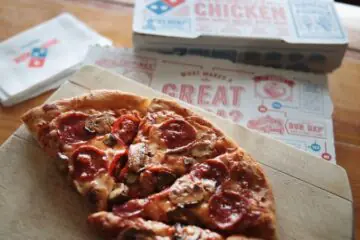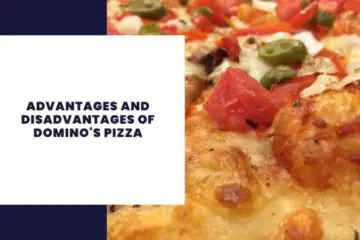What are Pizza Hut’s Weaknesses: Pizza Hut’s weaknesses include a perceived decline in food quality and a lack of innovation. The brand faces stiff competition from local pizzerias and fast-food chains.
Pizza Hut, one of the world’s most recognizable pizza chains, has experienced challenges keeping up with the dynamic food industry. Despite its strong brand recall and extensive global presence, customers often need to pay more attention to the consistency and taste of its offerings.
The pizza giant also needs help to introduce new concepts and menu items, which can result in a stagnant dining experience for customers craving novelty. Franchisees can sometimes feel the brunt of these weaknesses as they strive to meet the standards set by Pizza Hut while also contending with the company’s slower response to market trends. With a customer base that increasingly values quality and innovation, Pizza Hut must address these issues to maintain its market position and ensure long-term success.
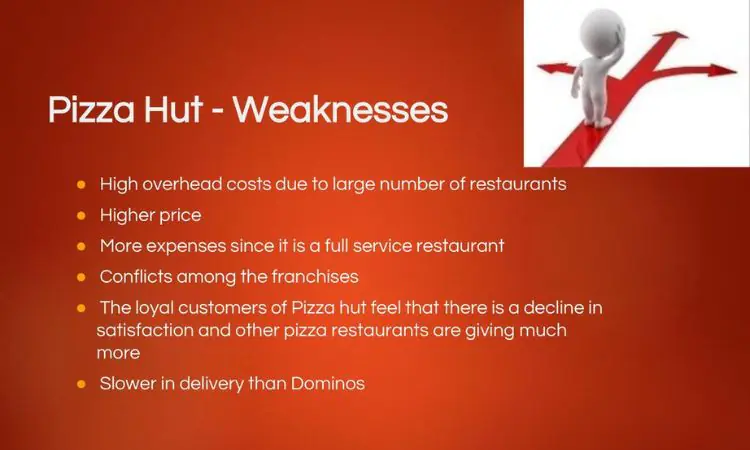
Introduction To Pizza Hut
Pizza Hut is an iconic pizza chain known worldwide. Its journey began in 1958, when two brothers, Frank and Dan Carney, opened the first Pizza Hut in Wichita, Kansas. With their success, Pizza Hut blossomed into an international power. Today, the name Pizza Hut echoes in the hearts of pizza fans worldwide.
Brand Legacy And Global Presence
The brand reached landmark status quickly. It expanded beyond the United States within a decade. The secret? Simple: consistency and quality. Pizza Hut became a household name, creating a legacy with memorable traits. Red roofs, the iconic logo, and the unforgettable slogan “No One Out Pizzas the Hut” distinguish Pizza Hut in the market.
- Loyal customer base across the globe
- Over 16,000 restaurants worldwide
- Market share: recognizable pillar in the pizza industry
The Pizza Industry Landscape
The pizza market is dynamic and competitive. Various brands have emerged, but Pizza Hut knows the drill. The brand stays at the forefront despite changes. Pizza Hut must adapt to trends shifting towards healthy options and tech advances. The challenge is real. Staying relevant is key in an evolving industry.
| Market Players | Unique Selling Points |
| Pizza Hut | Legacy, Brand Recognition |
| Competitors | Innovation, Health Options |
Dwindling Market Share
The dwindling market share of Pizza Hut represents a significant challenge for the global pizza giant. Known for its signature pan pizzas and inventive toppings, the brand now faces a tough journey to reclaim its dominance in a fast-evolving industry. A closer look into recent sales trends and growing competition sheds light on this predicament. Understanding these factors could be crucial for Pizza Hut’s strategic planning.
Recent Sales Trends
Recent years have yet to be kind to Pizza Hut’s sales figures. Data reveals a consistent dip, making stakeholders nervous. This decrease signals a wider issue that needs immediate attention. Charts indicate that younger diners overlook Pizza Hut and choose alternative dining options. Here are key points:
- Revenue: Shows a steady decline over the past quarters.
- Store Count: A reduction in the number of operational outlets worldwide.
- Consumer Preference: A shift towards healthier and more diverse dining experiences.
Competition From Fast-casual Pizza Chains
Competition remains fierce in the pizza industry, particularly from fast-casual chains. These competitors offer quick service, customizable menus, and an appealing dining atmosphere. With its traditional sit-down model, Pizza Hut finds it challenging to keep pace. Below are three main contenders:
| Brand | Unique Selling Proposition | Market Growth |
| Domino’s | Efficient delivery system | Upward trajectory |
| Blaze Pizza | Build-your-own pizzas | Rapid expansion |
| MOD Pizza | Artisan-style pizzas | Steady increase |
Pizza Hut must innovate vigorously to reclaim a significant chunk of the market. Adaptation and a customer-centric approach could be the keys to turning the tide.
Consumer Taste And Preferences Shift
As we delve into Consumer Taste and Preferences Shift, Pizza Hut, though a giant in the pizza industry, faces challenges. These obstacles grow as diners evolve in their expectations from fast-food joints. The marketplace today reacts quickly to changing taste buds and health trends. Let’s explore how these transformations affect Pizza Hut’s stronghold.
The Rise Of Health-conscious Eating
Times have changed, and so have the pizza lovers’ plates. Health-conscious choices are rising to fame as more individuals opt for greens over grease. Pizza Hut, known for its cheesy indulgences, finds this wave challenging.
- Fiber-rich crusts are in demand.
- Customers seek organic, non-GMO ingredients.
- The demand for vegan and vegetarian options increases
- Low-calorie menus catch more glances
Pizza Hut’s heavy toppings and stuffed crusts clash with the lean and clean meals preferred today. To keep pace, a menu revamp that prioritizes fresh and wholesome choices could be vital.
Changing Expectations For Pizza Quality
Diners demand more than just a quick bite; they seek a gourmet experience. With many artisanal pizzerias popping up, Pizza Hut’s traditional recipe is under scrutiny.
| Consumer Expectation | Pizza Hut Challenge |
| Authentic flavor profiles | Adaption beyond the classic tastes |
| Customizable pizzas | Flexible and varied ingredient options |
| Fresh, locally sourced ingredients | Shift from global suppliers to local produce |
Quality is key, and with a deviation toward craftsmanship in baking, Pizza Hut’s approach must evolve. Enhancing the crust’s texture, embracing diverse ingredients, and offering build-your-own pizzas could meet these expectations.
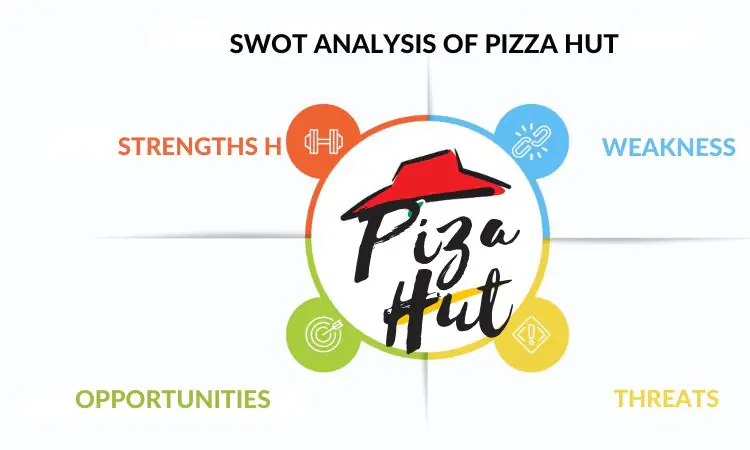
Menu Innovation Challenges
The ever-evolving palate of consumers presents a unique challenge for established brands in the fast-food landscape. For giants like Pizza Hut, innovating their menu is critical for staying ahead in a competitive market. Let’s delve into the specific hurdles Pizza Hut faces regarding menu innovation.
Difficulty In Refreshing The Menu
Pizza Hut often encounters challenges when introducing new items. Maintaining the essence of their brand while onboarding fresh and trendy offerings is a delicate balance. Consider the following points:
- Consumer expectations lean towards familiar flavors, deterring drastic changes.
- The pressure to maintain fast service limits elaborate menu additions.
- Ensuring consistent quality across all franchises can complicate new rollouts.
Balancing Tradition And Innovation
Pizza Hut’s legacy is rooted in its classic recipes and nostalgic dining experience. In their quest for innovation, striking a balance between the old and the new is complex. Let’s assess this balancing act.
| Tradition | Innovation |
| Signature dishes that loyal customers love. | Market demands for healthy, modern options. |
| Familiar tastes that define the brand. | Experimentation with bold, international flavors. |
| Proven recipes that streamline kitchen operations. | Unique ingredients that may require new preparation methods. |
Ultimately, the ability to evolve while honoring the brand’s heritage is a key test for Pizza Hut. Success hinges on their capacity to meet new tastes without alienating the base that built their global empire.
Supply Chain Issues
The Supply Chain Issues are a significant challenge for Pizza Hut. They affect everything from ingredient availability to delivery times. Let’s dive into the specifics.
Dependency On Specific Suppliers
Pizza Hut’s operations rely heavily on a select group of suppliers. This presents a substantial risk. Bottlenecks can occur if suppliers face disruptions. This impacts the consistency of Pizza Hut’s service and product availability.
- Delays in cheese and flour delivery
- Shortage of fresh produce during unforeseen events
- Limited options for supplier substitution
Impact Of Global Events On Supply
Global events can dramatically affect Pizza Hut’s supply chain. Strikes, natural disasters, and pandemics can delay or halt ingredient supply. This challenge can lead to menu item shortages and harm customer satisfaction.
- Transportation strikes are slowing down deliveries.
- Natural disasters causing supply disruptions
- Pandemics leading to operational constraints
Operational Inefficiencies
Certain operational inefficiencies affect Pizza Hut’s performance. Identifying these weaknesses helps understand areas needing improvement. Operational efficiency matters for customer satisfaction and business growth.
Outdated Restaurant Models
Some Pizza Hut locations are stuck in the past, featuring an old design. Customers today prefer modern and cozy environments, and this mismatch can drive diners to competitors with fresher looks and experiences.
Inconsistent Customer Service
Customer service quality at Pizza Hut sometimes varies. This inconsistency can frustrate diners. Loyal customers expect equal service on each visit. Varying experiences might lead to negative reviews and loss of patronage.
Franchise Relations
Franchise relations play a pivotal role in the success of global brands like Pizza Hut. Yet, even industry giants face challenges within their franchise networks. Let’s delve into some of the internal issues Pizza Hut encounters with its franchisees, which can indirectly affect customer satisfaction and brand consistency.
Tensions With Franchisees
At times, a gap emerges between corporate objectives and franchisee expectations. Disagreements may arise over operational practices, marketing strategies, or financial arrangements. Such friction can lead to strained relationships that require careful, diplomatic resolution to prevent a negative impact on the entire brand.
Varied Quality Across Locations
Pizza Hut’s vast franchise network can lead to inconsistent customer experiences. Quality control becomes a challenge, with each franchise potentially operating slightly differently. To maintain high standards, rigorous and regular quality checks are necessary—a logistical challenge that Pizza Hut works continuously to address.
- Strict adherence to recipes and service standards can be difficult to enforce.
- Customer feedback sometimes indicates variance in pizza quality from location to location.
- Ensuring uniformity in training and resources for franchises can mitigate these issues.
Marketing Missteps
Even giants can stumble, and Pizza Hut is no exception in its journey to captivate the taste buds of pizza lovers worldwide. Within the competitive realm of restaurant marketing, certain strategies can either yield success or leave companies with a half-baked presence in the minds of their target audience. Let’s explore the marketing challenges that Pizza Hut faces, focusing on some notable ‘Marketing Missteps.’
Ineffective Advertising Campaigns
Pizza Hut’s past promotions could have done better. Whether it’s an unclear message or a failure to resonate with specific audiences, these misfired advertisements can result in a lukewarm response from customers who would otherwise be ready to indulge. This affects immediate sales, brand loyalty, and long-term growth.
- Ads failing to highlight unique selling points
- Overlooking customer feedback in campaign designs
- Not effectively communicating special offers and discounts
Lack Of Digital Marketing Prowess
With screens becoming the storefronts of our time, a solid online presence is make-or-break for restaurants like Pizza Hut. Early on, they needed to adapt to this digital transformation faster. This hesitation put them a slice behind aggressive competitors.
| Aspect | Drawback |
| Website User Experience | Not as intuitive or appealing as needed |
| Social Media Engagement | Lacks the creativity to go viral |
| Online Ordering System | It is not as user-friendly, resulting in lost sales |
SEO-optimized changes and social media strategy updates are critical for gaining the upper hand in today’s digital-first marketplace. These are necessary for Pizza Hut to avoid challenges in reaching new and existing customers online.
Digital Presence And E-commerce
Even giants can stumble, and Pizza Hut is no exception in its journey to captivate the taste buds of pizza lovers worldwide. Within the competitive realm of restaurant marketing, certain strategies can either yield success or leave companies with a half-baked presence in the minds of their target audience. Let’s explore the marketing challenges that Pizza Hut faces, focusing on some notable ‘Marketing Missteps.’
Ineffective Advertising Campaigns
Pizza Hut’s past promotions could have done better. Whether it’s an unclear message or a failure to resonate with specific audiences, these misfired advertisements can result in a lukewarm response from customers who would otherwise be ready to indulge. This affects immediate sales, brand loyalty, and long-term growth.
- Ads failing to highlight unique selling points
- Overlooking customer feedback in campaign designs
- Not effectively communicating special offers and discounts
Lack Of Digital Marketing Prowess
With screens becoming the storefronts of our time, a solid online presence is make-or-break for restaurants like Pizza Hut. Early on, they needed to adapt to this digital transformation faster. This hesitation put them a slice behind aggressive competitors.
| Aspect | Drawback |
| Website User Experience | Not as intuitive or appealing as needed |
| Social Media Engagement | Lacks the creativity to go viral |
| Online Ordering System | It is not as user-friendly, resulting in lost sales |
SEO-optimized changes and social media strategy updates are critical for gaining the upper hand in today’s digital-first marketplace. These are necessary for Pizza Hut to avoid challenges in reaching new and existing customers online.
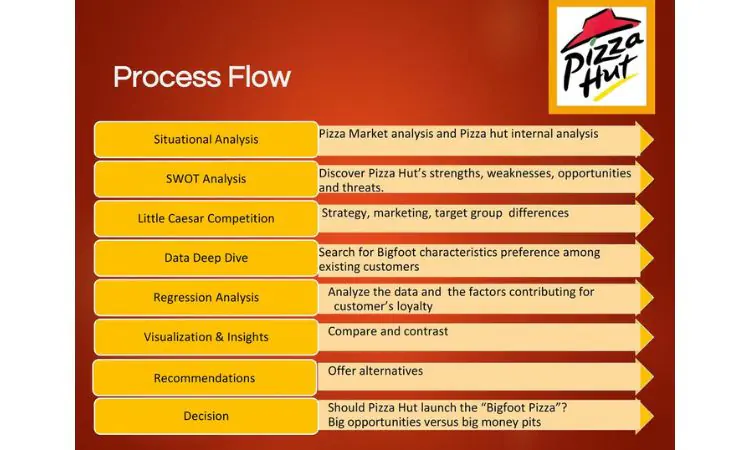
Frequently Asked Questions Of What Are The Weaknesses Of Pizza Hut
What Are The Disadvantages Of Pizza Hut?
Some disadvantages of Pizza Hut include higher prices than competitors, inconsistent quality across different locations, and limited healthier food options. The chain also faces strong competition, potentially affecting market share and customer loyalty.
What Are The Weakness Of Pizza Hut?
Pizza Hut’s weaknesses include higher pricing compared to competitors, less variety in healthy options, and inconsistent quality across different locations. They also need stiff competition from local pizzerias and fast-food joints.
What Is A Swot Analysis For A Pizza Business Plan?
A SWOT analysis for a pizza business plan evaluates Strengths (unique recipes), Weaknesses (limited delivery area), Opportunities (online ordering growth), and Threats (local competition). It helps in strategic planning and decision-making.
What Are The Disadvantages Of Pizza Business?
The pizza business faces stiff competition, leading to tighter profit margins. High ingredient costs and spoilage can affect financial stability. Seasonal fluctuations may also impact consistent revenue generation. Staffing challenges and evolving health trends can create obstacles to business growth.
Conclusion
Wrapping up, Pizza Hut shows room for improvement in several areas. From updating its menu to streamlining delivery times, tackling these weak spots could enhance its competitive edge. Ultimately, the brand can address these issues head-on to satisfy more customers and bolster its market position.

As the author of the “Ultimate Pizza Guide: Recipes, Tips & Secrets Revealed,” I’m dedicated to sharing my love for pizza and empowering others to create delicious homemade pizzas with ease. Join me on a journey to uncover the secrets to perfecting your pizza game!

